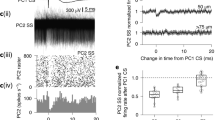Abstract
CONJUNCTIVE stimulation of climbing and parallel fibres in the cerebellum evokes a long-term depression of parallel-fibre Purkinje-cell transmission1,2 a phenomenon implicated as the cellular mechanism for cerebellar motor learning3 It is suspected that the increase in cyclic GMP concentration that occurs after activation of climbing fibres4 is required to evoke long-term depression3. Excitatory amino acids are known to cause the release of nitric oxide (NO), resulting in elevation of the cGMP level in the cerebellum5. Here we report that endogenous NO is released after stimulation of climbing fibres, that long-term depression evoked by conjunctive stimulation of parallel and climbing fibres is blocked by haemoglobin (which strongly binds NO) or L-NG-monomethyl-arginine (an inhibitor of NO synthase), and that exogenous NO or cGMP can substitute for the stimulation of climbing fibres to cause long-term depression in rat cerebellar slices. These results demonstrate that the release of endogenous NO is essential for the induction of synaptic plasticity in the cerebellum.
This is a preview of subscription content, access via your institution
Access options
Subscribe to this journal
Receive 51 print issues and online access
$199.00 per year
only $3.90 per issue
Buy this article
- Purchase on Springer Link
- Instant access to full article PDF
Prices may be subject to local taxes which are calculated during checkout
Similar content being viewed by others
References
Ito, M., Sakurai, M. & Tongroach, P. J. Physiol. (Lond.) 324, 113–134 (1982).
Sakurai, M. J. Physiol.(Lond.) 394, 463–480 (1987).
Ito, M. A. Rev. Neurosci. 12, 85–102 (1989).
Biggio, G. & Guidotti, A. Brain Res. 107, 365–373 (1976).
Garthwaite, J., Charles, S. L. & Chess-Williams, R. Nature 336, 385–388 (1988).
Shibuki, K. Neurosci. Res. 9, 69–76 (1990).
Moncada, S., Palmer, R. M. J. & Higgs, E. A. Biochem. Pharmac. 38, 1709–1715 (1989).
Karachot, L., Ito, M. & Kanai, Y. Expl Brain Res. 66, 229–246 (1987).
Shibuki, K. & Okada, D. Neurosci. Lett. 113, 34–39 (1990).
Bredt, D. S. & Snyder, S. H. Proc. natn. Acad. Sci. U.S.A. 87, 682–685 (1990).
Sakurai, M. Proc. natn. Acad. Sci. U.S.A. 87, 3383–3385 (1990).
Konnerth, A., Llano, I. & Armstrong, C. M. Proc. natn. Acad. Sci. U.S.A. 87, 2662–2665 (1990).
Knöpfel, T., Audinat, E. & Gähwiler, B. H. Eur. J. Neurosci. 2, 726–732 (1990).
Bredt, D. S., Hwang, P. M. & Snyder, S. H. Nature 347, 768–770 (1990).
De Camilli, P., Miller, P. E., Levitt, P., Walter, U. & Greengard, P. Neuroscience 11, 761–817 (1984).
De Vente, J., Bol, J. G. J. M. & Steinbusch, H. W. M. Brain Res. 504, 332–337 (1989).
Gally, J. A., Montague, P. R., Reeke, G. N. Jr., Edelman, G. M. Proc. natn. Acad. Sci. U.S.A. 3547–3551 (1990).
Ito, M. & Karachot, L. Neuro Report 1, 129–132 (1990).
Author information
Authors and Affiliations
Rights and permissions
About this article
Cite this article
Shibuki, K., Okada, D. Endogenous nitric oxide release required for long-term synaptic depression in the cerebellum. Nature 349, 326–328 (1991). https://doi.org/10.1038/349326a0
Received:
Accepted:
Issue Date:
DOI: https://doi.org/10.1038/349326a0
This article is cited by
-
Neuronal Nitric Oxide Synthase Critically Regulates the Endocannabinoid Pathway in the Murine Cerebellum During Development
The Cerebellum (2022)
-
Nonspecific synaptic plasticity improves the recognition of sparse patterns degraded by local noise
Scientific Reports (2017)
-
The Brain NO Levels and NOS Activities Ascended in the Early and Middle Stages and Descended in the Terminal Stage in Scrapie-Infected Animal Models
Molecular Neurobiology (2017)
Comments
By submitting a comment you agree to abide by our Terms and Community Guidelines. If you find something abusive or that does not comply with our terms or guidelines please flag it as inappropriate.



